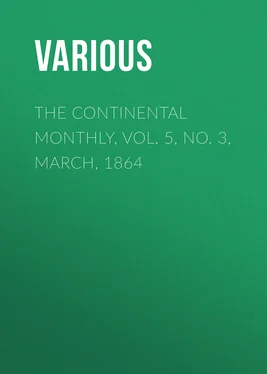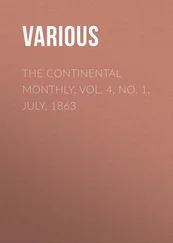Various - The Continental Monthly, Vol. 5, No. 3, March, 1864
Здесь есть возможность читать онлайн «Various - The Continental Monthly, Vol. 5, No. 3, March, 1864» — ознакомительный отрывок электронной книги совершенно бесплатно, а после прочтения отрывка купить полную версию. В некоторых случаях можно слушать аудио, скачать через торрент в формате fb2 и присутствует краткое содержание. Жанр: foreign_antique, periodic, Языкознание, Политика, foreign_edu, на английском языке. Описание произведения, (предисловие) а так же отзывы посетителей доступны на портале библиотеки ЛибКат.
- Название:The Continental Monthly, Vol. 5, No. 3, March, 1864
- Автор:
- Жанр:
- Год:неизвестен
- ISBN:нет данных
- Рейтинг книги:3 / 5. Голосов: 1
-
Избранное:Добавить в избранное
- Отзывы:
-
Ваша оценка:
- 60
- 1
- 2
- 3
- 4
- 5
The Continental Monthly, Vol. 5, No. 3, March, 1864: краткое содержание, описание и аннотация
Предлагаем к чтению аннотацию, описание, краткое содержание или предисловие (зависит от того, что написал сам автор книги «The Continental Monthly, Vol. 5, No. 3, March, 1864»). Если вы не нашли необходимую информацию о книге — напишите в комментариях, мы постараемся отыскать её.
The Continental Monthly, Vol. 5, No. 3, March, 1864 — читать онлайн ознакомительный отрывок
Ниже представлен текст книги, разбитый по страницам. Система сохранения места последней прочитанной страницы, позволяет с удобством читать онлайн бесплатно книгу «The Continental Monthly, Vol. 5, No. 3, March, 1864», без необходимости каждый раз заново искать на чём Вы остановились. Поставьте закладку, и сможете в любой момент перейти на страницу, на которой закончили чтение.
Интервал:
Закладка:
Man, elevated by knowledge in the scale of being, controls the forces of nature with greater power and grander results, and accumulates wealth more rapidly. The educated free labor of Massachusetts, we have seen, doubles the products of toil, per capita , as compared with Maryland, and quadruples them (as the Census shows) compared with South Carolina. One day's labor of a man in Massachusetts is more than equal to two in Maryland, and four in South Carolina. So, if we take our savage tribes, with their huts and tents, their rude agriculture, their furs, their few and simple household manufactures, their hunting and fishing, the average product of their annual labor, at four cents a day each, would be $14.60 a year, or more than a fourth of that of South Carolina (56.91). So that Massachusetts, in material progress, is farther in advance of South Carolina than that State is of the savage Indians. Thus we have the successive steps and gradations of man: Massachusetts, with free labor and free schools, having reached the highest point of civilization: South Carolina, with slavery and ignorance (except the few), in a semi-barbarous stage; and the lowest savage condition, called barbarous, but nearer to South Carolina than that State to Massachusetts.
Slavery, then, the Census proves, is hostile to the progress of wealth and population, to science, literature, and education, to schools, colleges, and universities, to books and libraries, to churches and religion, to the press, and therefore to free government; hostile to the poor, keeping them in want and ignorance; hostile to labor, reducing it to servitude, and decreasing two thirds the value of its products; hostile to morals, repudiating among slaves the marital and parental condition, classifying them by law as chattels, darkening the immortal soul, and making it a crime to teach millions of human beings to read or write. And shall labor and education, literature and science, religion and the press, sustain an institution which is their deadly foe?
The discussion will be continued in my next letter. R. J. Walker.
PALMER, THE AMERICAN SCULPTOR
Sculpture as an art is probably anterior to painting. Form being a simpler quality than color, the means of imitation were found in a conformity of shape rather than hue. The origin of sculpture is somewhat obscured in the thickening mists of antiquity, but it was no doubt one of the earliest symbols of ideas made use of by man. In fact, in its primitive development, there is considerable evidence to show that it was the first essay at a recorded language. The Egyptian hieroglyphics, those mysterious etchings upon the rock, representing animals, men, and nondescript characters, were unquestionably rude attempts to hand down to posterity some account of the great events of those forgotten ages. The next remove in the history of this art is its employment in the production of the images of idolatrous worship; and, when confined to this purpose, it never attained any appreciable excellence. The purely heathen mind was incapable of conceiving those forms of ideal beauty which are born of the contemplation of a divine and spiritual beauty revealed in the word of God and the teachings of his immaculate Son.
The grotesque Egyptian images worshipped on the Nile before the building of the pyramids, are, judging from the best preserved antiquities, not very much inferior to the gilded deities to be seen to-day in the thousand pagodas of heathen lands.
Take for example a Chinese idol of modern make: while it is less angular and more elaborately finished than the ancient monstrosities found in Egypt, still, so far as perfection of form or beauty of expression is concerned, there is little to choose between the two. Each is a fitting type of the degree of civilization and soul culture of the peoples that produced them. It must not be urged that the success of sculpture in Greece and Rome disproves the proposition that the art could not develop itself among a strictly idolatrous race.
The splendid mythologies of the Greeks and Romans must not be considered as the highest forms even of the worship of idols or inanimate things. The gods and goddesses of these mythological systems were principally the powers that were supposed to preside over the different forces and elements of nature, and were invested with the celestial attributes of a higher order of beings. Neptune ruled the sea, Pluto was director of ceremonies in the infernal regions, while Jupiter was emperor of the sky and king of all the lesser gods.
These deities were the invention of a cultivated intellect, a refined taste and polished civilization, and furnish a striking proof of man's longing after the Infinite, unguided by the star of revelation.
The imaginative Greeks did not worship the statues of the gods per se , but only admired them as the fitting representations of those mysterious forces that hold sway over earth, air, fire, and water, or reverenced them as the symbols of noble sentiments or sublime passions. The thing itself, the cunning but lifeless figure, was only incidental, while the idea thus typified was the real incentive to worship. This was also the age that produced hero worship, and the great man who won the praise and admiration of the people by his exalted qualities, or his prowess in arms, was considered as a demigod, or one in favor with the tenants of Olympus, and his statue was accordingly erected, to stand beside that, perhaps, of Mars, Apollo, or Mercury.
Thus we trace the history of sculpture in its steady progress from its use as a chronicler of events to its employment in the production of the objects of idolatry, and thence to the mythological period, when it became the medium of æsthetic expression, attaining its highest perfection in the palmy days of Greece.
In no people of which the records of the past give any account, can we find such an active sense of the beautiful as that which permeated the minds of the polished Greeks. The admiration of physical beauty became an almost absorbing passion, and its attainment was sought after in every process which human ingenuity could devise.
The Lacedemonian women were accustomed to place the statues of beautiful gods or goddesses in their rooms, to the end that the children they should give birth to, would, by nature's mysterious methods, assimilate the artistic graces of these celestial models. Perfection of form and manly strength were the pride of the wisest and most learned men of the nation, denoting that physical excellence was considered the necessary concomitant of moral or intellectual worth. Authentic annals tell us that Plato and Pythagoras appeared as wrestlers at the public games; and who shall say that these philosophical gymnasts did not derive much of their mental vigor from this exciting exercise? In this age it is easy to see that sculpture must have received every incentive to full development. In the people about him the artist saw the most excellent models for his chisel, while the national taste was educated to the highest degree in the beauties of form and the harmonies of proportion.
But the grand conceptions of Phidias, full of majesty and of grandeur as they are—the matchless finish of the works of Apelles and Praxiteles, ravishing the senses with their carnal beauty, still lacked one element, without which art can never reveal itself in the full perfection of its latent capabilities.
Mere physical beauty, which contains no spiritual element, no drawing of the immortal soul, no suggestion of purer and nobler sentiments struggling for expression in the cunning marble, can never satisfy the requirements of the Christianized taste of modern times.
The Venus de Medici was undoubtedly the ideal type of womanly perfection in the age which produced it, but now the sex would hardly feel themselves flattered by so poor an interpretation. The form is all that could be desired, but the head and features are positively insipid, and a phrenologist would tell you by the development of the cranium that female education was not a part of the Grecian policy. There is in this statue a certain air of wantonness, a perceptible consciousness of being valued and admired solely for physical beauty, which just as plainly tells the estimate placed upon woman in those times as we can read the fact in history.
Читать дальшеИнтервал:
Закладка:
Похожие книги на «The Continental Monthly, Vol. 5, No. 3, March, 1864»
Представляем Вашему вниманию похожие книги на «The Continental Monthly, Vol. 5, No. 3, March, 1864» списком для выбора. Мы отобрали схожую по названию и смыслу литературу в надежде предоставить читателям больше вариантов отыскать новые, интересные, ещё непрочитанные произведения.
Обсуждение, отзывы о книге «The Continental Monthly, Vol. 5, No. 3, March, 1864» и просто собственные мнения читателей. Оставьте ваши комментарии, напишите, что Вы думаете о произведении, его смысле или главных героях. Укажите что конкретно понравилось, а что нет, и почему Вы так считаете.












